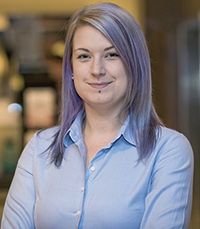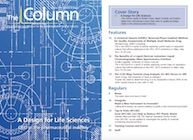A Design for Life Sciences
The Column spoke to Robert Shaw, Steph Turnbull, and Sophie Bailes from AstraZeneca about their work in quality by design (QbD) in the pharmaceutical industry.
Eyematrix/stock.adobe.com

The Column spoke to Robert Shaw, Steph Turnbull, and Sophie Bailes from AstraZeneca about their work in quality by design (QbD) in the pharmaceutical industry.
Q. Why is quality by design important in the pharmaceutical sector?
A: For the pharmaceutical industry to deliver efficacious and safe medicinal products to patients, we require robust and reliable manufacturing processes. These processes require accurate and reproducible analytical measurement systems. The principles of quality by design (QbD) enable a holistic and structured approach to developing our products and processes, building in reliability from the start. In this interview, we are focusing on analytical method life cycle QbD, which uses these principles, whether a full method operable design region (MODR) is required to be registered or not.
Q. How would you define design of experiments (DoE) and are there any misconceptions surrounding DoE?
A: Design of experiments is a general technique for learning about processes efficiently and can be applied in many different areas (1–10). It provides a structured approach, so that maximum information on experimental parameters (or factors) is obtained from a limited number of experiments. In concept, it allows many parameters to be varied simultaneously, enabling a fuller understanding of potential interdependency between parameters called interaction effects. Key benefits include improved efficiency (both in terms of reduced time and reduced materials) and increased robustness of the conditions developed. The approach encompasses logistical issues so that design plans are practical to perform.
There are some common misconceptions surrounding DoE. One of these is that using experimental design methods will mean doing more experiments than the analyst would normally do. DoE is actually an efficient process that, when applied well, will enable learning to be developed and decisions made in a shorter time with a lower cost for materials compared with a traditional one-factor-at-a-time (OFAT) approach. The OFAT approach may in some cases achieve a desirable result, however, the true optimum can be missed, and the experimentation does not yield useful information on interactions or a robust operating region.
Another misconception is when the analyst thinks that there are so few variables for a method that DoE is not worth applying. The practical steps involved make DoE a valuable approach regardless of how few or many parameters are involved.
Some analysts say they can’t understand the DoE output and prefer to run the experiments in their own way. In our experience the most important output is graphical and visually impactful and avoids the need to interpret complex statistical analysis.
Q. How does DoE relate to quality by design?
A: DoE is vital to QbD. The goal of QbD is to develop a process (or procedure) that operates reliably and robustly, every single time, without the need for repeats, reâruns, or re-testing. This is often referred to by designing quality into your process. To enable this, a thorough understanding of the method is vital. DoE provides this, by not only efficiently mapping all your key parameters to provide a robust operating region, but also by the process of identifying and categorizing all possible factors as one of Constant, Noise, or eXperimental factors (called CNX approach). This thought process alone can often yield improvements by identifying all possible sources of method variability, so the benefits DoE can bring to QbD can potentially occur even before any laboratory work has taken place.
Q. How can the analyst use DoE in practice to develop robust analytical methods for quality control (QC) environments?
A: An analytical method is a process that can also be optimized by DoE. Every analytical method will have many parameters that affect its performance; some of which are method controlled, for example, flow rate, gradient, eluent, and others which could be potential noise factors, such as operator, column age, sample preparation.
DoE can provide the optimum conditions and understanding of critical method parameters (CMP) that need to be controlled. This control can be achieved through choosing specific critical method attributes (CMA) for the system suitability criteria to give a robust and stable method performance. A structured planning approach is recommended to ensure that the objectives of the DoE are met and to avoid ambiguous results and conclusions because of confounding effects of “nuisance” factors or incorrect sample sizes applied.
Q. What approaches would you recommend to maximize benefit from DoE?
A: A sequential approach to DoE allows building knowledge through a growing set of experimental data: scoping, screening, optimization. A small number of scoping trials run at variable conditions can identify you are running in the correct region. Screening trials will assess the CMP and their interactions with a few more experiments. The last set of experiments will target the optimum operating range, exploring the robustness of that region. As you progress through these stages, you can make small changes to the parameters and their settings, allowing a more flexible approach rather than a large “one-off” set of experiments.
Development of a DoE support strategy is also key. We have developed a working model including different layers of expertise and support including a) a small team of statisticians and chemometricians, b) technical support from subject matter experts, c) analyst “lead users”-amenable and capable with statistical principles and techniques, who have been trained in the software, and d) the general analyst population. We feel it is important to raise the statistical awareness and skill level of scientists, so they can carry out basic statistical analysis and data visualization, and know when to involve a statistician. To this end, we have developed a suite of short statistical workshops, which have been well attended by the analyst community.
In our experience, the most successful examples have been developed by bringing together the respective expertise of scientist and statistician.
Q. What other benefits can DoE offer chromatographers?
A: Since DoE is highly structured, it allows chromatographers to use a standardization approach to method development so that methods are developed more efficiently (10). By exploiting automated technologies, such as multiple column switching and quaternary solvent mixing on the instrument, DoE can provide further gains in efficiency. Furthermore, any troubleshooting further down the method life cycle would be able to refer to the DoE findings to facilitate faster root cause analysis and targeted method improvements. For example, if the buffer concentration was shown to be a critical parameter affecting method performance during the DoE, it would direct the analyst to first assess mobile phase preparation during a laboratory investigation of a failure of resolution of critical pair in the system suitability solution.
Q. Can you illustrate this with some “real-world” examples?
A: The following two liquid chromatography (LC) examples demonstrate the diverse application of DoE from early- to late-stage method development.
The first illustrates the robustness of DoE as part of method development. During method development, it is recommended to perform a generic DoE to identify the critical method parameters and thereby introduce system suitability criteria that will adequately control the method throughout routine use. The parameters selected for the DoE are those commonly observed as critical parameters in chromatography methods: flow rate, Δ%B, temperature, buffer concentration, and wavelength. Through the use of automation, two different settings for dwell volume were incorporated into the DoE along with two different columns.
Statistical analysis of the DoE quickly highlighted observed variation in the percentage area for one impurity, which was being caused through column selection. This variation was investigated further and was determined to be a result of onâcolumn degradation, probably due to metal contamination on the surface of the column. The pH of the mobile phase was subsequently reduced to control the risk of degradation of this impurity in the presence of metals.
Early adoption of this type of DoE approach to understand robustness of the method during development can be used to identify potential issues with the method. A risk assessment is then performed to understand whether this issue can be controlled during routine operation of the method or whether the method parameters should be redeveloped. Had the method not been assessed using this approach, the risk of out of specification (OOS) would have been high and could have potentially sparked a long and ultimately futile investigation. The use of this structured DoE approach identified the true root cause quickly and unambiguously.
A second example illustrates how we use a DoE to validate an impurities method during preregistration. At AstraZeneca, we have adopted the Enhanced Method approach for validation of the MODR of commercial chromatography methods. Following the initial scoping and development work to identify the CMPs, a DoE was used to establish the ranges. Four factors were identified from previous experimental work; three factors (temperature, flow rate, and Δ%B) were controlled by the equipment, while one factor (buffer concentration) was more analyst-dependent. Responses included relative retention times for each peak, and the resolution between critical pairs.
Although it had a smaller impact, the buffer concentration was more important to understand because this would be the hardest to control through the routine use of the method. Through understanding of the boundaries of failure for the buffer concentration, the preparation volumes of the mobile phase were defined in the method to reduce the likelihood of method failure when transferred into our QC testing sites.
Q. Are there any other take-away messages?
A: The laboratories of today are smarter than ever, with advances in automation and equipment allowing generation of vast amounts of data in a relatively short amount of time. DoE can capitalize on this by structuring the planning of experiments, resulting in spending less time in the laboratory whilst achieving greater understanding of your methods.
DoE provides benefits to chromatographers from early development right through to late-stage investigations. When applied early, intelligent experimental design will generate understanding of your separation mechanism and develop robust methods. Later-stage application enables knowledge transfer to QC laboratories in order to have full control and insight throughout the method life cycle.
References
- T. Farrant, Practical Statistics for the Analytical Scientist: A Bench Guide (The Royal Society of Chemistry Information Services, 1997).
- J.C. Miller and J.N. Miller, Statistics for Analytical Chemistry 3rd Edition (Ellis Horwood Analytical Chemistry Series, 1993).
- G.E.P. Box, J.S. Hunter, and W.G. Hunter, Statistics for Experimenters (Wiley, 1978).
- Proposed New United States Pharmacopeia General Chapter <1220> “The Analytical Procedure Lifecycle” (United States, Pharmacopeial Convention, Rockville, Maryland, USA).
- J. Springall, American Pharmaceutical Review (2018) https://www.americanpharmaceuticalreview.com/Featured-Articles/348755-How-to-Utilize-Design-of-Experiment-DoE-Principles-for-Developing-Robust-Analytical-Methods-for-QC-Environments/
- A. Rignall et al., Pharmaceutical Technology42(12), 18–23 (2018).
- P. Jackson et al., Anal. Chem. 91(4), 2577–2585 (2019).
- M. Schweitzer et al., Pharmaceutical Technology34(2), (2010).
- The Sequential Nature of Classical Design of Experiments: https://www.prismtc.co.uk/resources/blogs-and-articles/article-the-sequential-nature-of-classical-design-of-experiments
- D. Asberg et al., J. Pharm. Biomed. Anal. 129, 273–281 (2016).

Robert Shaw is a Principal Scientist in statistics and Chartered Statistician at AstraZeneca working within pharmaceutical development and manufacturing. He has worked with AstraZeneca (formerly Zeneca, ICI) for nearly 30 years covering a variety of leadership and technical roles in research, development, and production. His main technical interests include design of experiments, statistical tool development, statistical quality monitoring and control, and in vivo models. His role has included collaborating and consulting with scientists to embed statistical good practice principles and tools, and deliver bespoke statistical design, analysis, and interpretation to in vitro and in vivo experiments.

Steph Turnbull is a Senior Scientist in statistics at AstraZeneca, with a career starting as an analytical chemist, before specializing in process analytics and chemometrics for industrial processes. Statistician, chemometrician, multivariate analyst, designer of experiments, process analytical chemist, and fluent in MATLAB, she has worked in a wide variety of data-driven areas from data mining through to multivariate statistical analysis, supporting investigations from lab-scale through to global multi-site manufacturing processes.

Sophie Bailes completed her Ph.D. in separation science with Prof. Mel Euerby, with research focused on fundamental separation mechanisms of polar analytes in reversed-phase LC and hydrophilic interaction liquid chromatography (HILIC) modes. She joined AstraZeneca in 2005 and held a leading role for the successful evaluation and implementation of UHPLC technology across global pharmaceutical development. As Associate Principal Scientist for Separation Science in Global Chemical Development, Sophie leads method development activities using a range of analytical technologies such as ultrahighâpressure liquid chromatography (UHPLC), supercritical fluid chromatography (SFC), gas chromatography (GC), and ion chromatography (IC), and computational and predictive tools. More recently, Sophie took on board the challenges of analytical life cycle management, with a special interest in robustness testing, analytical method validation, and technical transfer. As subject matter expert in this field, Sophie provides leadership for the implementation of corresponding processes and standards across all AstraZeneca development and QC testing sites.
E-mail:Robert.shaw@astrazeneca.com / Stephanie.turnbull@astrazeneca.com / Sophie.bailes@astrazeneca.comWebsite: www.linkedin.com/in/stephturnbull / www.linkedin.com/in/sophie-bailes-7b1b931b

Regulatory Deadlines and Supply Chain Challenges Take Center Stage in Nitrosamine Discussion
April 10th 2025During an LCGC International peer exchange, Aloka Srinivasan, Mayank Bhanti, and Amber Burch discussed the regulatory deadlines and supply chain challenges that come with nitrosamine analysis.












